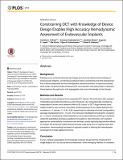| dc.contributor.author | O’Brien, Caroline C. | en_US |
| dc.contributor.author | Kolandaivelu, Kumaran | en_US |
| dc.contributor.author | Brown, Jonathan | en_US |
| dc.contributor.author | Lopes, Augusto C. | en_US |
| dc.contributor.author | Kunio, Mie | en_US |
| dc.contributor.author | Kolachalama, Vijaya B. | en_US |
| dc.contributor.author | Edelman, Elazer R. | en_US |
| dc.date.accessioned | 2016-04-01T15:47:57Z | |
| dc.date.issued | 2016 | en_US |
| dc.identifier.citation | O’Brien, Caroline C., Kumaran Kolandaivelu, Jonathan Brown, Augusto C. Lopes, Mie Kunio, Vijaya B. Kolachalama, and Elazer R. Edelman. 2016. “Constraining OCT with Knowledge of Device Design Enables High Accuracy Hemodynamic Assessment of Endovascular Implants.” PLoS ONE 11 (2): e0149178. doi:10.1371/journal.pone.0149178. http://dx.doi.org/10.1371/journal.pone.0149178. | en |
| dc.identifier.issn | 1932-6203 | en |
| dc.identifier.uri | http://nrs.harvard.edu/urn-3:HUL.InstRepos:26318611 | |
| dc.description.abstract | Background: Stacking cross-sectional intravascular images permits three-dimensional rendering of endovascular implants, yet introduces between-frame uncertainties that limit characterization of device placement and the hemodynamic microenvironment. In a porcine coronary stent model, we demonstrate enhanced OCT reconstruction with preservation of between-frame features through fusion with angiography and a priori knowledge of stent design. Methods and Results: Strut positions were extracted from sequential OCT frames. Reconstruction with standard interpolation generated discontinuous stent structures. By computationally constraining interpolation to known stent skeletons fitted to 3D ‘clouds’ of OCT-Angio-derived struts, implant anatomy was resolved, accurately rendering features from implant diameter and curvature (n = 1 vessels, r2 = 0.91, 0.90, respectively) to individual strut-wall configurations (average displacement error ~15 μm). This framework facilitated hemodynamic simulation (n = 1 vessel), showing the critical importance of accurate anatomic rendering in characterizing both quantitative and basic qualitative flow patterns. Discontinuities with standard approaches systematically introduced noise and bias, poorly capturing regional flow effects. In contrast, the enhanced method preserved multi-scale (local strut to regional stent) flow interactions, demonstrating the impact of regional contexts in defining the hemodynamic consequence of local deployment errors. Conclusion: Fusion of planar angiography and knowledge of device design permits enhanced OCT image analysis of in situ tissue-device interactions. Given emerging interests in simulation-derived hemodynamic assessment as surrogate measures of biological risk, such fused modalities offer a new window into patient-specific implant environments. | en |
| dc.language.iso | en_US | en |
| dc.publisher | Public Library of Science | en |
| dc.relation.isversionof | doi:10.1371/journal.pone.0149178 | en |
| dc.relation.hasversion | http://www.ncbi.nlm.nih.gov/pmc/articles/PMC4764338/pdf/ | en |
| dash.license | LAA | en_US |
| dc.subject | Medicine and Health Sciences | en |
| dc.subject | Surgical and Invasive Medical Procedures | en |
| dc.subject | Stent Implantation | en |
| dc.subject | Hematology | en |
| dc.subject | Hemodynamics | en |
| dc.subject | Physical Sciences | en |
| dc.subject | Mathematics | en |
| dc.subject | Numerical Analysis | en |
| dc.subject | Interpolation | en |
| dc.subject | Biology and Life Sciences | en |
| dc.subject | Biotechnology | en |
| dc.subject | Medical Devices and Equipment | en |
| dc.subject | Cardiovascular Medicine | en |
| dc.subject | Cardiovascular Imaging | en |
| dc.subject | Angiography | en |
| dc.subject | Diagnostic Medicine | en |
| dc.subject | Diagnostic Radiology | en |
| dc.subject | Imaging Techniques | en |
| dc.subject | Radiology and Imaging | en |
| dc.subject | Cardiovascular Procedures | en |
| dc.subject | Coronary Stenting | en |
| dc.subject | Tomography | en |
| dc.subject | Physics | en |
| dc.subject | Classical Mechanics | en |
| dc.subject | Continuum Mechanics | en |
| dc.subject | Fluid Mechanics | en |
| dc.subject | Fluid Dynamics | en |
| dc.subject | Flow Rate | en |
| dc.title | Constraining OCT with Knowledge of Device Design Enables High Accuracy Hemodynamic Assessment of Endovascular Implants | en |
| dc.type | Journal Article | en_US |
| dc.description.version | Version of Record | en |
| dc.relation.journal | PLoS ONE | en |
| dash.depositing.author | Kolandaivelu, Kumaran | en_US |
| dc.date.available | 2016-04-01T15:47:57Z | |
| dc.identifier.doi | 10.1371/journal.pone.0149178 | * |
| dash.contributor.affiliated | Kolandaivelu, Kumaran | |
| dash.contributor.affiliated | Edelman, Elazer | |


